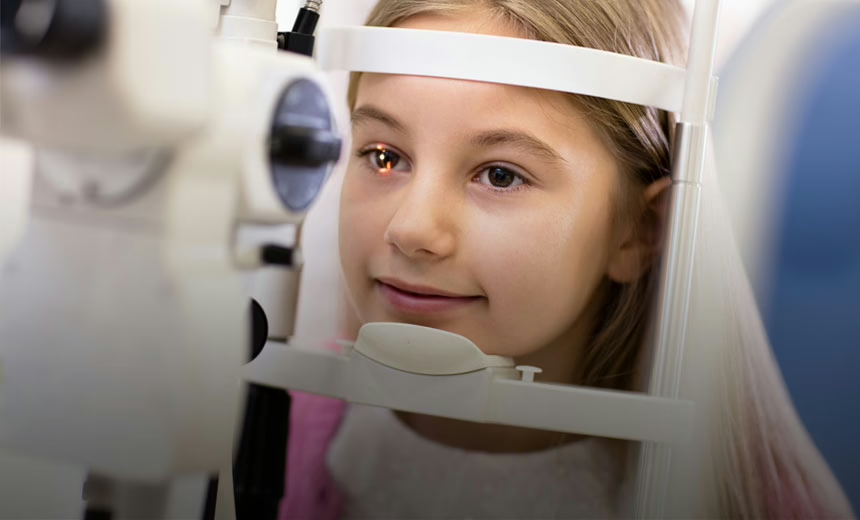"*" indicates required fields
Cataracts in children
21/01/2021

A cataract is a clouding of the lens of the eye – the effect is like looking through a smudged window, except the smudge can’t be wiped clean. While most cataracts occur in adults over 60, there are a surprising number of children who are affected.
Cataracts impact around 1 in 5000 children in Australia1 and if left untreated, can cause blindness.
What causes cataracts in a child?
Cataracts present at birth are known as congenital cataracts. It is estimated that approximately 25% of congenital cataracts have a genetic cause.2 For example, one parent may have been born with a cataract in one or both eyes. Cataracts are also associated with genetic disorders like metabolic, hormonal or chromosomal abnormalities (e.g. trisomy 21) and infections during pregnancy, such as rubella. Congenital cataracts can also occur when the lens hasn’t formed correctly. This may be the result of abnormal interactions amongst the proteins that make up the lens of the eye. These can go on to cause specks and clumping that can create cloudy areas.
Children can also develop cataracts after birth (acquired). Acquired cataracts can be caused by:
- Use of steroids in oral, eye drop and ointment form (prednisolone)
- Eye trauma
- Diabetes and other metabolic diseases
- A complication of other diseases, such as eye inflammation (uveitis) or rheumatoid arthritis
- Radiation therapy after cancer.
How do cataracts affect a child’s vision?
Cataracts can rarely be seen without specialist equipment as they are positioned too far back within the eye. A baby can be expected to track objects quite well after they are 3 to 4 months old, so the inability to do so at the four-month-mark may indicate a problem.
Sometimes a cataract can be so small that a child won’t notice a problem. However, this will depend on the visual demands their activities place on them. For example, a child may be able to play with friends normally but have difficulty reading. While an adult can quickly recognise if there is an issue with their vision, children can find it more difficult to ascertain if a problem is present. As a child becomes older and the demands on their vision increase, any problems caused by the cataract will become more obvious.
Common cataract symptoms include:
- Blurry or cloudy vision
- Decreased vision
- Colours appear dull or faded
- Double vision
- Lights appear too bright and may produce glare and halos.
Other issues to look out for include:
- Jiggling eye movements (involuntary eye movements, also known as nystagmus)
- Misaligned eyes – when the eyes don’t look in the same direction.
It is important to make an appointment with an optometrist or ophthalmologist if you notice any of the above symptoms in your child.
Treatment for cataracts in children
Although children born with a cataract are able to live a full and normal life, some will require treatment. Depending on the severity of the clouding, the child’s visual acuity and their age, there are different ways of dealing with cataracts.
These include:
- Performing cataract surgery to remove the cloudy lens and replace it with an artificial lens
- Glasses
- Contact lenses
- A combination of these treatments.
Cataract surgery is a routine and safe surgery. If a child is born with a dense cataract, it’s best to remove it within 2 to 4 months. Removing cataracts as soon as possible promotes good long-term vision in a child. For this reason, it is important to attend the six-week baby check to assess your child’s red reflex* or be seen by a paediatric ophthalmologist if there are any concerns.
* The red reflex is the normal, red-orange reflection of light from the back of the eye that is seen when your child’s eye is examined with an ophthalmoscope (similar to ‘red eye’ in photos). This simple, non-invasive test can screen for many eye conditions in babies, including cataract.
References
2. Shiels A, Hejtmancik JF. Genetic Origins of Cataract. Arch Ophthalmol 2007;125(2):165–173.
Enjoyed this article?
More articles by this author
Dr Rushmia KarimMore articles on this subject
Children’s eye healthThe information on this page is general in nature. All medical and surgical procedures have potential benefits and risks. Consult your ophthalmologist for specific medical advice.
Date last reviewed: 2023-05-19 | Date for next review: 2025-05-19
